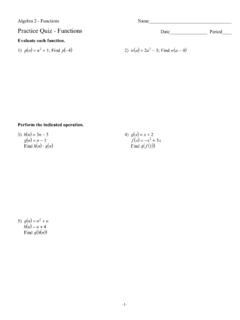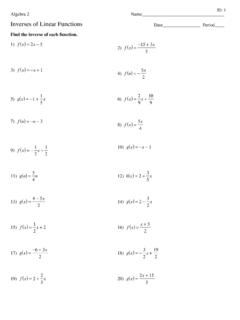Transcription of Name: Date: Period: Inverses and Transformations of ...
1 Name: date : Period: Inverses and Transformations of exponential and logarithmic Functions ____LG : Investigate and apply previously learned rules for transforming functions and exponential and logarithmic functions and make connections to different functions. Part 1: Inverses : We can calculate the inverse of an exponential and logarithmic function algebraically: Example1: Find the inverse of the function =log! : = = = Example 2: Find the inverse of the function = ! = . = . = . 1: Find the inverse of the following functions: = = = . Part 2: Parent exponential and logarithmic Functions: PARENT exponential Graphs: = y-intercept at (0,1) No x-intercept Asymptote at = (x-axis) o This means that the graph will never touch the x-axis.
2 PARENT logarithmic Graphs: = x-intercept at (1,0) No y-intercept Asymptote at = (y-axis) o This means that the graph will never touch the y-axis. Part 3: Shifts of exponential and logarithmic Graphs: Recall the following basic Transformations of functions: Category 1: ( ) horizontal shift (left and right) Category 2: + vertical shift (up and down) Category 3: ( ) reflection over the y-axis Category 4: ( ) reflection over the x-axis 1. Using desmos, graph the functions on the same axes as their parent functions: a) = ( ! ) b) = ( ! ) c) = ( ! ) What transformation Category (1,2,3, or 4) do the functions fall under? _____ Does the asymptote change in the examples above? Does the x or y intercept change? Explain: 2. Using desmos, graph the functions on the same axes as their parent functions: a) = ( ) b) = ( + ) c) = ( ) What transformation Category (1,2,3, or 4) do the functions fall under?
3 _____ Does the asymptote change in the examples above? Does the x or y intercept change? Explain: 3. Using desmos, graph the functions on the same axes as their parent functions: a) = + b) = c) = + What transformation Category (1,2,3, or 4) do the functions fall under? _____ Does the asymptote change in the examples above? Does the x or y intercept change? Explain: 4. Using desmos, graph the functions on the same axes as their parent functions: a) = b) = + c) = What transformation Category (1,2,3, or 4) do the functions fall under? _____ Does the asymptote change in the examples above? Does the x or y intercept change? Explain: Part 4: Reflections of exponential and logarithmic Graphs: 1. Using desmos, graph the functions on the same axes as their parent functions: a) = ( ) What transformation Category (1,2,3, or 4) do the functions fall under?
4 _____ Does the asymptote change in the examples above? Does the x or y intercept change? Explain: b) = ! What transformation Category (1,2,3, or 4) do the functions fall under? _____ Does the asymptote change in the examples above? Does the x or y intercept change? Explain: 2. Using desmos, graph the functions on the same axes as their parent functions: a) = ( ) What transformation Category (1,2,3, or 4) do the functions fall under? _____ Does the asymptote change in the examples above? Does the x or y intercept change? Explain: b) = ( ) What transformation Category (1,2,3, or 4) do the functions fall under? _____ Does the asymptote change in the examples above? Does the x or y intercept change? Explain: Part 5: Mastery of Transformations Write function rules for the following Transformations : a) The graph =3!
5 Is translated 2 units right b) The graph =5! is reflected over the x-axis c) The graph =log! is reflected over the y-axis d) The graph =log! is translated 4 units up e) The graph =log is translated 3 units down and 5 units left. f) The graph =2! is translated 3 units down and 5 units left. Graph and label the functions below: a) = = ! = + = ! = b) = (hint: how does this relate to = )? = ( ) = ( )+ = ( ) = ( ) Part 6: Connections to other types of functions: 1. Classify the following functions as Quadratic, exponential , Radical, or logarithmic : a) = 3!+2 Type of Equation: b) =5!!!+2 Type of Equation: c) = 3+2 Type of Equation: d) =log 3+2 Type of Equation: a) What do the functions above have in common?
6 B) What transformation is represented by each of the functions above? How do you know? 2. Below are the parent functions for quadratic, exponential , radical, cubic, absolute value, and logarithmic functions. Write the function rule for a transformation of 6 units left, 3 units down. The first one has been done for you: a) ( )= Example: ( )= +6 3 b) ( )= ! c) ( )=8! d) ( )=log e) ( )= ! f) ( )=









